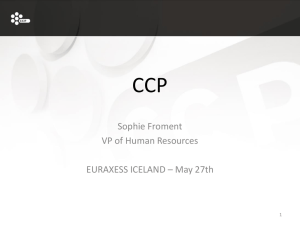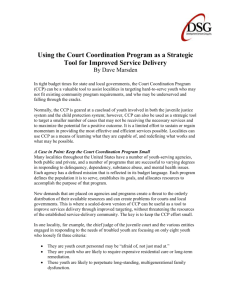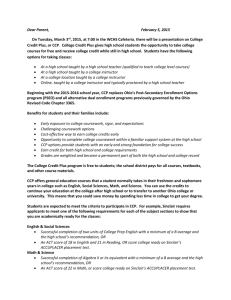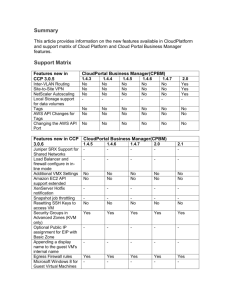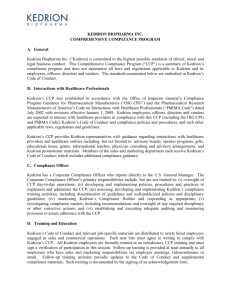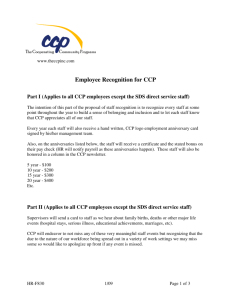Cowichan Tribes Comprehensive Community Planning Challenges
advertisement
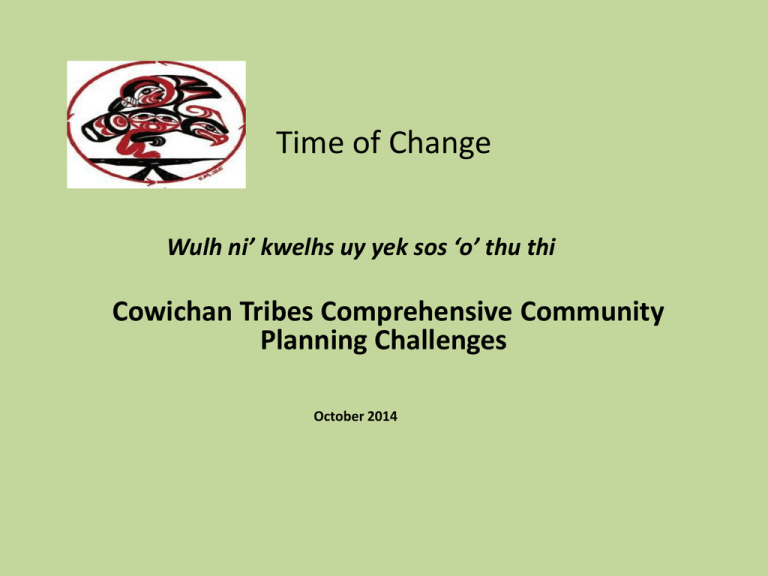
Time of Change Wulh ni’ kwelhs uy yek sos ‘o’ thu thi Cowichan Tribes Comprehensive Community Planning Challenges October 2014 Cowichan Tribes is the largest band in BC with 4,800 members and half of our members live off reserve. The sheer size of the community created many challenges for the CCP Team, including community engagement, gaining community support, and reaching our elders. The Beginning: 2007 -2008 Our work began with one year of CCDP, ending in 2008. Some of the challenges were: • One staff member working on his own: lack of staff support (one-person team) • Lack of direction and mentorship • Consultant driven, not Community Driven How that Has Changed • Mentorship Program was put in place and helped staff move forward. • More control by staff to ensure that the CCP was Community Driven. • New consultants for technical support • More staff support, support from Chief and Council and support from Managers. • CCP Working group was created and included staff, managers, elders, youth and community members. Starting again: 2011 to Present • • • • • New Challenges: Engaging OFF reserve, as half of our members live off reserve. Engaging youth, as they are spread out in 7 public schools, 6 private schools and 3 band schools. We have 7 villages and it was difficult to engage all villages equally. It was difficult to get many members out to community dinners. Door to door updates, invitations to events took a lot of staff time as there are 530 homes on the reserves. How We Overcame These Challenges • Engaging OFF reserve: Interviewing at Tim Horton’s, went to our off-reserve housing apartments (7) and dropped off flyers. • Engaging youth: Went to most of the schools and tried to capture all age groups in different classrooms, and went to the youth centre and friendship centre. • Engaging all 7 villages and families: Had barbecues in the villages, had family dinners, coffee time and went door to door. • Low turnout for community dinners: Instead of doing more community dinners, we piggybacked on other community events had open houses that included staff and members. • Door to door Invites: We hired students to go door. More Challenges • Lack of continuous Funding which was overcome by applying for different funding sources. • Lack of continuity, staff turnover and lack of staff. • Change of management and supervisors. • Lack of a champion. • Challenged by managers tight schedules. • Not having the consultants at all times- the work became overwhelming. More Challenges • Our Community announced a State of Emergency due to the climbing rate of suicides. That became a priority for one year. Our community needed the emotional support for the losses that they were suffering through. • Short staffed, team members were unable to move forward in the work due to illnesses/family dynamics. • Tragic incident in the community prevented plan moving forward. • Presenting to the Chief and Council - removed from the agenda due to more pressing issues in the community- such as suicides and deaths. Gathering information and putting it together was challenging • We had so much information from the past work, and projects that departments were working on or just completed that gathering and sorting took a lot of time. • For example: Work already being done Health, wellness and safety: Embracing Life Strategy (2013 -2014) Suicide Workshops (2014) ASSIST program (2014) Turning Stones Program (2014) Community Health Plan (2010) Ts’ewuhltun Health Department Strategic Plan (2012) Community Mobilization (2013 -2014) Safety Strategy (2014) Guardian Program (2014 – Mulaqw Road) Land, Resources, Community and Governance Housing Strategy (2014) Housing Department Apartment Planning (2014) Land Code (Under development – to be completed in 2016) City of Duncan Active Transportation Plan (CT involvement) TransCanada Highway Corridor Plan (CT involvement) Annual General Meetings (Initiated April 2014) Operational Plan (2013) Human Resources Department Strategic Plan (2014) Communications Strategy (2014) Land Use Planning Framework (2013 -2014) Watershed Board (CT involvement) Environmental Farm Plan (CT involvement) Youth, Education and Employment Youth Recreation Committee NAIG Legacy Program Youth Council Youth Survey (Health) (2012) Youth Engagement Strategy Quw'utsun Syuw'entst Lelum Education Strategic Plan (2014) Operational Plan (2013) –youth and culture initiatives Khowutsun Development Corporation (KDC) Strategic Five Year Plan (2012) Independent Opportunities Program (IOP) Social Development Department (2010/Ongoing program) Education Department (Various programs) Education Strategic Plan (2014) Yuthuythut Adult Learning Centre and training program Data Analysis • We had a lot of data to analyze, which would have been impossible for our CCP team to do. Our consultants, EcoPlan did this work for us. Issues analysis: Influence diagrams Issues: Influence diagrams Issues: Influence diagrams We combined them… Issues: Influence diagrams …then simplified them… Issues: Influence diagrams ROOT CAUSE A BIT OF BOTH …then conducted some analysis. SYMPTOMS Issues & Values Community (2012 Open House ranking): 1. Housing 2. Education 3. Health & Wellness 4. Economic Development (i.e., Jobs) 5. Safety 6. Sustainability 7. Self-sufficiency 8. Support for youth 9. Governance (comm./vision) 10.Infrastructure Staff (from dept. interviews- 2011) • Housing • Capacity building • Inadequate/inapp ropriate services • Communication/v ision/leadership • Budget/funding • Land ecology and food connection Leadership (from Strategic/Operation al Plan) • Housing • Capacity building • Quality of service and programs for youth • Communications Strategy • Departmental planning and implementation • Culture • Financial and administrative governance Exceptions: High-priority issues …then developed general strategies. AND WE DID IT • We completed our CCP Document • During the process, we completed a Land Use Planning Framework and atlas • We started a Transportation and Mobility Plan • Now we are challenged with filling in the remaining gaps that we found through the CCP process Gaps - Four strategic areas: • • • • Street safety and mobility Community-based planning and cohesion Health and wellbeing Employment support Summary of CCP related achievements Projects supported by CCP Housing Strategy Embracing Life Strategy Community Mobilization and Safety Strategy Transportation and Mobility plan Community Safety Plan Capacity Building Engagement and planning process GIS HUY'TSEEP'QU
